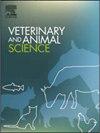Spata22在不育雄牛-牦牛睾丸中的分子特征及表达
IF 1.9
Q2 AGRICULTURE, DAIRY & ANIMAL SCIENCE
引用次数: 0
摘要
牛和牦牛杂交的雄性是不育的,而雌性是可育的。这是由精子发生过程的异常引起的。SPATA22在同源染色体配对、突触、DNA修复和减数分裂重组中起关键作用;其失调可破坏这些过程,导致哺乳动物减数分裂停滞和雄性不育。Spata22在不育杂交牛-牦牛中的表达及分子特性研究尚未完成。本研究对牛-牦牛Spata22基因的编码序列进行了分离、测序和鉴定,并比较了其相对mRNA和蛋白表达量。Spata22 mRNA和蛋白在牛-牦牛中表达量明显低于牦牛和牛。SPATA22蛋白位于小管腔室。在牛-牦牛序列中发现了13个突变位点,包括10个氨基酸改变和3个插入。牛-牦牛蛋白序列包含的基序是在减数分裂重组和DNA修复中起关键作用的基因的潜在结合位点。组织学检查未见晚期生殖细胞,除少量精原细胞、精母细胞和支持细胞外。这些发现为进一步了解Spata22基因在牛-牦牛杂交不育中的作用奠定了基础,并为今后在不育雄性牛-牦牛基因组中构建功能性Spata22基因拷贝以恢复不育雄性牛的正常精子发生奠定了基础。这将有助于通过杂交改善牦牛的理想性状。本文章由计算机程序翻译,如有差异,请以英文原文为准。
Molecular characterization and expression of Spata22 in testes of the sterile male cattle-yak
The male hybrid of cattle and yak is sterile, while the female is fertile. This is caused by aberrations with the process of spermatogenesis. SPATA22 plays a critical role in the pairing of homologous chromosomes, synapsis, DNA repair, and meiotic recombination; dysregulation of which can disrupt these processes, resulting in meiotic arrest and male sterility in mammals. The expression and molecular characterization of Spata22 have not been studied in the sterile hybrid cattle-yak. This study isolated, sequenced and characterised the coding sequence of the Spata22 gene of the cattle-yak, and compared the relative mRNA and protein expression. There was a remarkable reduction in Spata22 mRNA and protein expression in the cattle-yak compared to the yak and cattle. The SPATA22 protein was located in the adluminal compartment of the tubules. Thirteen mutation sites consisting of ten amino changes and 3 insertions were found in the cattle-yak sequence. The cattle-yak protein sequence contains motifs which are potential binding sites for genes that play a crucial role in meiotic recombination and DNA repair. Histological evaluation revealed no advanced-stage germ cells, except a few spermatogonia, spermatocytes and Sertoli cells. These findings give an insight into the role of Spata22 in the hybrid sterility of cattle-yak and pave the way for more future research into genetic engineering involving the construction of a functional Spata22 gene copy into the genome of sterile male cattle-yak to restore normal spermatogenesis in the sterile hybrid. This will help improve desirable traits in the yak through hybridization.
求助全文
通过发布文献求助,成功后即可免费获取论文全文。
去求助
来源期刊

Veterinary and Animal Science
Veterinary-Veterinary (all)
CiteScore
3.50
自引率
0.00%
发文量
43
审稿时长
47 days
 求助内容:
求助内容: 应助结果提醒方式:
应助结果提醒方式:


